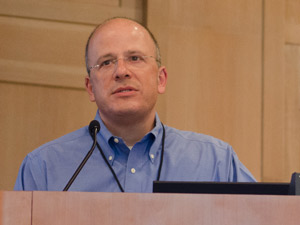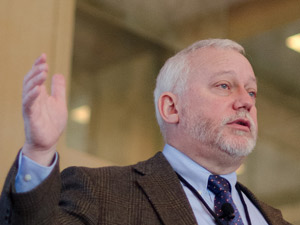
Interview: CHDI's scientific team
HDBuzz interviews the top scientists from CHDI, the largest funder of Huntington's disease research in the world.

The 2012 Huntington’s Disease Therapeutics Conference brought a hefty dose of news, excitement and optimism for people desperately waiting for effective treatments for HD. HDBuzz interviewed some of the leading scientific minds behind the Conference’s organizer, CHDI Foundation, Inc.
What is CHDI?
It’s a continuous source of surprise to us that many people from HD-affected families haven’t heard of CHDI, considering they are, by a long way, the largest funder of Huntington’s disease research around the world.

Image credit: Blumenstein/CHDI
CHDI’s structure and mission are highly unusual – not just within Huntington’s disease, but in any area of research. In many ways, CHDI resembles a commercial drug company – it has a management structure, has a pipeline of ‘targets’ and employs drug-hunting scientists, many with experience in the pharmaceutical industry. Yet CHDI is a non-profit organization, funded entirely from donations, with no need to deliver a financial return to shareholders. CHDI’s main motivation is time, not money. Uniquely, CHDI is committed entirely to developing treatments for one disease – Huntington’s – and, equally unusually, has no physical laboratories of its own, instead driving HD research through collaborations with academic and commercial researchers.
Our interview at the 2011 Conference covered CHDI’s unusual setup in detail. This year, we wanted to concentrate on what’s new and the palpable sense of excitement at the 2012 Conference around forthcoming trials of new drugs for HD.
An exciting time for drugs
As our tweets and reports from the Conference show, there’s a real feeling that 2012 will mark the beginning of a new era in Huntington’s disease drug development. Several long-awaited human trials of gene silencing are being planned, and CHDI’s parallel efforts to produce new drugs specifically targeting different problems in HD have advanced dramatically.
We started by asking Robert Pacifici, CHDI’s Chief Scientific Officer, what was different about these upcoming trials from what we’ve seen before. Three things make him optimistic, he replied. “The first is the number of shots on goal. We have a lot of things in the hopper that are at a very advanced stage. The second thing is diversity. If we were only focusing on one approach, I’d be really nervous, but we’re not – there’s diversity there.”
Pacifici and his chemistry and biology leads, Celia Dominguez and Ignacio Muñoz-Sanjuan, are rightly proud of the drugs they’ve painstakingly designed and tested. One thing that distinguishes the next generation of experimental drugs is that they were designed specifically for Huntington’s disease rather than re-tooled from other diseases – or as Dominguez puts it, “these molecules were hand-crafted for HD from the get-go. “
“There’s every chance of success – but if the trials fail, they’re still informative. Everything is going to give a definitive result”
The third change CHDI is aiming for goes to the very heart of what motivates researchers to run a clinical trial. “We’ve got things designed in a way that there’s every chance of success – but if they fail”, says Pacifici, “they’re still informative. Everything is going to give a definitive result.”
That requires two fundamental adjustments to the way trials are run. First, there has to be exhaustive testing of the drug before it reaches a human trial, to make sure it does what it’s supposed to. Second, the trial has to be designed in a way that allows the results to make sense, whether positive or negative.
Given the financial and time cost of trials, says Pacifici, it’s not enough to get a negative result and not know why. CHDI’s trial designs use three layers of ‘biomarkers’ to track the effects of a drug from hitting its target to having a “meaningful biological effect” on the disease. “It’s still possible, even with those three things, that the drug doesn’t fix Huntington’s, but if I know I’ve hit the target, and it doesn’t fix HD, I know that target is one to walk away from.”
As an example of CHDI’s approach, Pacifici cites caspase-6, an enzyme thought to be important for snipping the mutant huntingtin protein into poisonous fragments. CHDI worked intensively to study the enzyme, and to develop drugs to reduce its activity. But the more they discovered, the less promising it seemed as a treatment approach, and the hard decision was taken to discontinue the program. But CHDI didn’t just walk away from caspase-6, Pacifici points out. “We made sure we closed out the project properly and we’re publishing our findings, so that anyone else who was interested could pick it up. We’re happy to be proved wrong.”
A new approach
With gene silencing and exciting drugs like phosphodiesterase (PDE) inhibitors and KMO inhibitors rapidly moving towards clinical trials, if CHDI were a regular pharmaceutical company this might be the time to pause its efforts to discover new targets and develop new molecules. Instead, the Foundation has just unveiled a new approach to the problem of studying and developing treatments for HD – using systems biology.

Image credit: Blumenstein/CHDI
Keith Elliston is CHDI’s newly appointed Vice President for Systems Biology. “Biological systems,” explains Elliston, “have a particular nature to themselves that you cannot understand by looking at single parts one at a time. We have to look at the collection of parts as a whole, rather than individual components.”
It sounds so sensible, we wonder briefly why anyone would do anything differently. Elliston switches to history mode. “The molecular biology revolution fundamentally changed the way we think about biology. It took us from a state where we looked at whole systems as they function, to where we could tear them down to their atomic components. But it’s very clear that biological systems are much more complex than that.”
Fair enough, but isn’t Huntington’s disease basically a simple problem – a single genetic stutter, that causes the death of brain cells? Not quite, says Elliston. A cell with the HD mutation has “changed its nature – it’s not dead, it’s still alive, but it’s fundamentally altered. The challenge is to find out how it’s been altered, then how can we nudge the system back to a more favorable state”.
Elliston believes that systems biology presents a new way of approaching drug development. “Conventional wisdom says that if we make a drug that alters a single point in the system, we can change the way the system works. But drugs have many different effects, and it may be the collection of effects that nudge the system one way or another.”
In a sense, then, it seems like systems biology is about realizing that we’ve always been dealing with systems, perhaps without realizing it. Elliston has a neat analogy. “If I take a pin and push it against a balloon, I pop it. If I take a hand and push it at many points, it changes shape. It’s the same thing with biology. The more gently I push it, the more likely I am to move it from one state to another.”
Openness and sharing are important aspects of CHDI’s move towards systems biology. The Foundation has many academic and industry partners, and aims to bridge gaps where those traditional ways of working don’t always do well. “The key thing that CHDI can do is build the database – what are the right models we need, what are the mechanisms of disease – when we put these things together and package them up, we can basically kick off HD programs across the pharmaceutical industry, because we’ve done the biology.”
“Our strategy has been to make sure that nothing that’s on the critical path is beyond our control”
“Big pharma”
It’s been a mixed year for the pharmaceutical industry and Huntington’s disease. HD families were understandably disappointed when Novartis announced they were pulling the plug on their neurodegenerative disease program, including their HD work.
Meanwhile another drug giant, Pfizer, announced great preliminary results from its collaboration with CHDI, to develop PDE drugs to improve the functioning of the synaptic connections between neurons. Pfizer is now planning a drug trial which could begin as early as 2013.
Pacifici remains positive about the sometimes unpredictable involvement of commercial drug companies in HD research. “Because CHDI has the luxury of the long term and the financial resources,” he says, “we can rise above it. It’s disappointing when a company de-prioritizes things, but our strategy has been to make sure that nothing that’s on the critical path is beyond our control.”
From small seeds
CHDI has reinvented itself this year with a new logo – a tree made from connected structures – representing the chemistry of drug molecules, or possibly Elliston’s biological systems. It’s an apt image, since the seedlings that CHDI has been planting and nurturing these past seven years have oftentimes proved fragile and difficult to cultivate. But there’s a real sense, both within the Foundation and in the global community of HD researchers, that their efforts will be rewarded and every reason to believe that the forthcoming trials of drugs “designed specifically with HD in mind” will bear fruit. Or, at the very least, provide some shelter from the storm.
Learn more
Sources & References
For more information about our disclosure policy see our FAQ…


